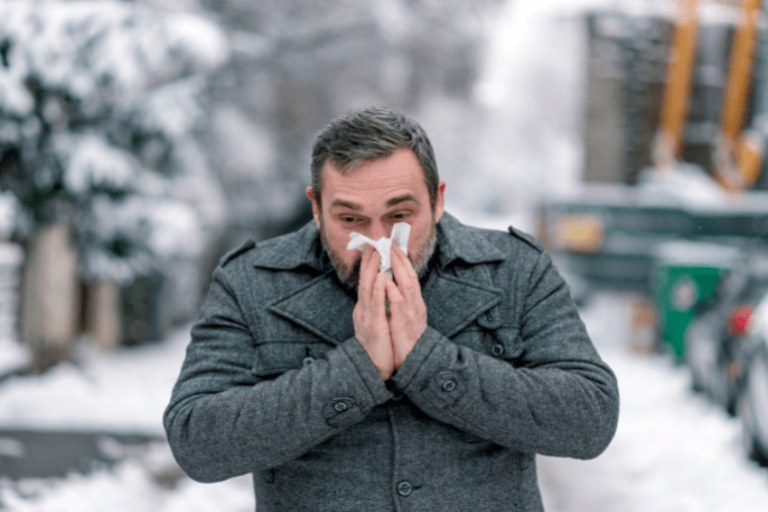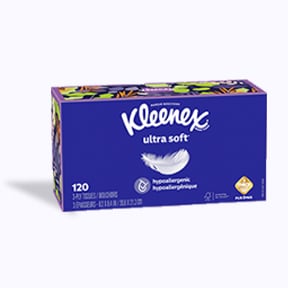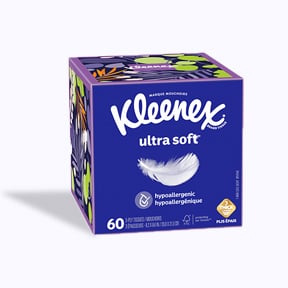
As the temperatures drop and the cold weather arrives you might assume your seasonal allergies will go away. But, if you suffer from common allergens such as mold and mildew, dust mites and pet dander, as you settle indoors for the winter season with the windows closed and the heater on -- your exposure to these allergens actually spikes1.
So, the sniffles and sneezing you experience may not be the result of a cold – rather, winter allergies, which are much more common than people think. We have the answers to all your questions, including how to diagnose winter allergies and what triggers them.
When winter allergies hit and you need some soothing relief, reach for our 3-layer Kleenex® Ultra Soft™ facial tissues for when only the softest touch will do.
Winter allergy symptoms
What's the difference between colds vs. winter allergies
There are a few other points of difference between winter allergies and colds, including²:
Winter Allergies |
Colds |
|
Nasal secretions are watery, clear |
Nasal secretions are discolored |
|
Itchy eyes and throat |
Chills and body aches |
|
Symptoms persist for weeks |
Symptoms are usually gone in a week |
If your friend or loved one caught the cold or flu. checkout our suggestions for how to make the ultimate get well care package that will surely bring a smile to their face.
What allergies are worse in the winter?
Are pet allergies worse in the winter?
What causes allergies during winter?
Surprisingly, many of the same allergens that trigger your allergies in the summer can be found in the winter. Because we spend more time indoors your allergies may even intensify due to more frequent and closer exposure. Some of the most common triggers2 in the winter include:
- Mold
- Dust Mites
- Dander
- Damp wood
- Temperate climates
Airborne molds are a common cause of allergies all year round and can be present indoors and outdoors. Indoor mold contamination often depends on the moisture levels inside your house.
Dust mites can be found practically everywhere inside your house. While there’s no getting rid of them completely, dialing up regular cleaning of surfaces and textiles in your home will help.
Pet dander can cause allergies at any time of the year, but as you hunker down for winter you might find you pet allergies to be worse due to all the time you and your pet are spending indoors.
Moist cut wood that’s been stored outside can become a breeding ground for mold spores. Bringing that wood inside for fires is an open invitation to allergy triggers.
Milder climates where there’s no, or few, hard freezes can result in the year-round presence of plant-based allergens like pollen
How to treat and get rid of winter allergies² ⁺ ³:
- Use Kleenex® facial tissues to soothe symptoms As Canada’s softest facial tissue brand*, Kleenex® Soothing Lotion™ tissues are infused with aloe and Vitamin E to nourish and protect skin. Consider keeping a box of Kleenex® facial tissues in the kitchen, living room, guest room, office, bathroom and bedroom so that the softest comfort for your nose is always at arm’s reach.
*among national brands
- Wash hands and face often
Washing your hands and face will reduce the amount of allergens that will enter your body.
- Wash bedding in hot water
As much as we may not want to think about this, dust mites and pet dander love to live on your bedsheets. Help minimize your exposure of these pesty allergens by washing your sheets, pillowcases, comforters and blankets in hot water (at least 130 °F)4 2-4 times a month.
- Vacuum often
Vacuuming can go a long way in reducing the amount of dust mites and pet dander in your environment – two of the most common winter allergens. If you’re noticing your allergies are especially bad during the winter, this is an excellent first preventative step to take.
- Use a humidifier
Dry air is common during the winter, and it becomes easier to find yourself dehydrated, which can exacerbate your symptoms. A humidifier can pump some much-needed moisture into the air and may even help reduce nasal congestion
- Check firewood
Firewood can be a breeding ground for moisture and mold so make sure that you’re storing yours in a dry, and well-ventilated environment, preferably outside. Only bring in new logs as you’re ready to burn them.
- Avoid smoke
While a crackling fire might sound romantic during the winter, smoke can aggravate existing allergies. You can reduce your exposure to it with a glass door over your fireplace if you find it bothering you or cut back on the number of open fires you have.
- Wipe your feet at the door
Many of the allergens found in your house were brought inside from your shoes or clothing. Removing your shoes at the front door or wiping your feet before you enter, especially after nature walks, is a simple step you can take towards reducing allergens in your home.
- Be smart with storage
Seasonal items like winter coats, hats, gloves, scarves and even home décor items should be stored in air-tight containers when not being used to prevent buildup of dust and mold.
- Carry a Kleenex® On-The-Go Pocket Pack
Winter allergies can sneak up on you like the first snowfall. That’s why it’s a good idea to always keep a Kleenex® On-The-Go Pocket Pack on-hand to provide immediate relief. These convenient tissue packs are made of 3-layers to comfort your face and help protect hands. Tuck them in your purse, gym bag, your child’s backpack or in the car so the comfort and superior softness of a Kleenex® tissue is always within reach.
With Kleenex® brand tissues, winter allergies won’t get you down! Learn more about pollen allergies in the Canada by checking out our article on tree pollens.
- https://www.webmd.com/allergies/winter-allergies
- https://www.webmd.com/allergies/features/winter-mold-allergies-risk
- https://www.zyrtec.com/allergy-guide/outdoors/understanding-winter-allergies
- https://www.nationaljewish.org/conditions/allergy/overview/lifestyle/winter-tips#:~:text=Some%20common%20symptoms%20of%20indoor,necessary%20for%20dust%20mite%20survival






